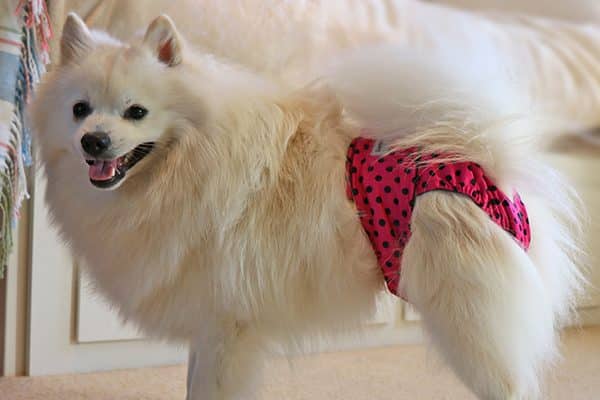Dogs in Heat: 9 Things to Know
Do dogs have periods? Not the same way that female humans do. Female dogs who aren’t spayed go into heat and the amount of time a female dog bleeds and when she’s fertile varies greatly from a human menstrual cycle. Let’s discuss some facts about dogs in heat — and why it’s important to spay your female dog!

Do you know these important facts about dogs in heat? Photography ©Cynoclub | Thinkstock.
1. A dog heat cycle only happens once or twice a year.
The canine estrus cycle (commonly referred to as the dog heat cycle) occurs every 6 to 12 months.
2. A puppy can go into heat sooner than you think.
The earliest that most dogs will experience their first heat cycle is at 6 months of age.
3. Dogs in heat should stay away from intact male dogs for 3 to 4 weeks.
This means that dogs in heat should not visit dog parks or do any doggie day care visits. “Anytime a dog is in heat, assume it’s going to be at least a month and keep them away from male dogs during that time,” says Nancy Kelso, DVM, medical director at VCA Columbia Animal Hospital at Hickory Ridge in Columbia, Maryland. “Generally, neutered males are fine, however, it’s also stressful for intact males to live in the same house as a female in heat so we usually recommend totally separating them.” If possible, send one of the dogs to stay with a relative or friend for a month or so.
4. Don’t think you’re in the clear once the bleeding stops.
With dogs in heat, each dog heat cycle lasts 3 to 4 weeks, but you will only see bleeding during the first 2 weeks. “The fertile period is actually when the bloody discharge starts to subside and it becomes pink or clear and there’s much less of it,” Dr. Kelso says. “Even the swelling of the vulva goes down substantially so a lot of people think the dog is out of heat, but no, that’s actually the prime fertile time.”

Dog pants, like this fun polka-dot option from Glenndarcy, are great for dogs in heat. Photography courtesy of Glenndarcy.
5. The bleeding from dogs in heat isn’t as bad as you might think.
“Fortunately, in most dogs it’s not a large amount, it’s relatively small,” Dr. Kelso explains. “Some people will use sanitary diapers for dogs.” With some dogs in heat, you won’t really notice the bleeding.
6. Don’t delay scheduling your dog’s spay.
Many people don’t ever experience dogs in heat since it’s best to have your female dog spayed prior to her first heat cycle. If your new rescue dog goes into heat before you can get her spayed, your vet might suggest waiting until she is done before spaying her. “It can be done while they are in heat or immediately after, but it’s not the ideal time because the uterus is much larger and much more vascular at that time,” Dr. Kelso says. “If we have the luxury of time, then the perfect scenario is we wait about two months after they’ve been in heat to spay them, but if we need to get it done because they’re getting adopted out then we’ll definitely spay shortly after heat or when we need to.”
7. Spaying your dog decreases her chances of developing mammary cancer.
Mammary cancer is the equivalent of breast cancer in dogs. Check your female pup regularly for lumps in her breast tissue (from her armpit to her groin). If you feel something suspicious, schedule an appointment with your vet.
8. Pyometra is another danger for female dogs who aren’t spayed.
Pyometra is an infection of the uterus. It can be deadly and almost always requires an emergency spay surgery. If the infection is “open” (meaning the cervix is open) it can be easier for veterinarians to diagnose because there is usually foul-smelling discharge from the vaginal area. “Dogs can also have a variety where the cervix is closed, so the pus is actually building up inside the dog and those dogs get really sick,” Dr. Kelso says. “They don’t eat, they don’t drink and they run a high fever. If you see any of those symptoms, you should bring her in to a veterinarian.”
9. Dogs in heat know when they are in heat and fertile — and when they are not.
“Dogs know when they’re ready to be bred,” Dr. Kelso says about dogs in heat. “They get a little more flirtatious. Sometimes they might be a little grumpy at the beginning of heat. If a dog tries to mount them or something, they’re basically saying, ‘I’m not ready.’”
Thinking about keeping your dog intact? Read this first >>
Thumbnail: Photography by Claudio alexandre Cologni/Thinkstock.
This piece was originally published in 2017.
